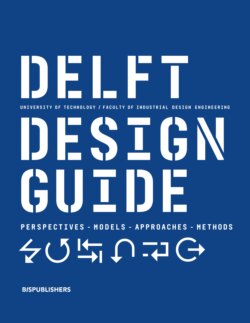Читать книгу Delft Design Guide -Revised edition - Annemiek van Boeijen - Страница 46
На сайте Литреса книга снята с продажи.
ОглавлениеBasic Design Cycle
MODELS
45
How? The model describes five reasoning steps, each with its own purpose. As mentioned, these steps can happen, for example, in a span of a few seconds or over a period of weeks depending on the resolution level you take.
----------------
Analyse: In this step, you examine the aspects related to your design goal or a design problem. Overall, analytical reasoning yields information that informs your design criteria and eventually the requirements.
----------------
Synthesise: In this step, you generate pos- sible solutions. Synthesis yields (elements of) design proposals that potentially offer valuable (parts of) solutions to the problem.
----------------
Simulate: In this step, you create imagined, digital, or physical representations of
(elements of) design proposals. Simulation yields representations either in your mind or externalised with which you can evaluate their potential value.
----------------
Evaluate: In this step, you reason about the potential value of design proposals through their simulated representation. This happens in relation to design criteria. Evaluation produces an understanding of the current value of (an element of) your design proposal and informs design making.
----------------
Decide: In this step, you reason about the relative value of (an element of) your design proposal and you decide on how to proceed. Decision making informs the next cycles of design: whether to repeat a cycle, proceed to (an element of) your design proposal, or focus on other elements instead.
What & Why? The model describes the different basic reasoning steps a designer goes through when solving a design problem purposefully and consciously. Theoretically, you can go through only a single cycle, but you usually perform many cycles across the various phases of any design process. The basic design cycle consists of five reasoning steps that are logically connected. Novice or naïve designers often tend to ‘jump’ over some of the steps, which might harm the quality of the design outcome. For example, one might immediately ‘jump to solutions’ when presented with a design brief, without thoroughly analysing the problem. This reasoning might result in a design that does not address the actual problem. Ideally, you spiral from problem to solution, from abstract to concrete, and from function to product geometry. This process is usually iterative, in which you sometimes have to take a few steps back – ‘back to the drawing board!’ – to go a step forward later on. You might also enter into the cycle at different steps, as long as you complete the cycle each time. Being aware of the basic cycle that you are going through on different resolution levels – from a cycle within the time span of a minute to cycles that span several weeks – helps you to organise your thoughts and design activities.
--------------------------------------------------------------------------------------------------------------------
Mindset: The Basic Design Cycle represents a fundamental cycle of reasoning that is inherent in conscious, purposeful design problem solving. This means that a designer who desires to do so needs to critically reflect on how his or her own thinking corresponds to basic reasoning logic.
--------------------------------------------------------------------------------------------------------------------
Tips & Concerns
Do not confuse the five reasoning steps with the phases of a design process. The Basic Design Cycle is a model describing the fundamental reasoning steps and their relative logical order, which happen throughout any conscious, goal-directed design process.
----------
This means that there is not one phase in which you synthesise, but that you must engage in synthesis throughout the design process.
----------
When you ‘get lost’ in your ideas and thoughts, you might find it helpful to consider which step of the basic cycle you are in and identify which reasoning steps you might have missed that might get you back on track.
----------
Discussion with others often helps in effectively doing these reflections.
-----------------------------
Limitations
‘Analyse’ is the first step in this model, and this might suggest that it should also be your point of departure. However, that step is not necessarily your preferred point for starting your design cycle.
----------
Depending on your preference, you can enter into the cycle at different points.
The Basic Design Cycle is a model that represents the fundamental reasoning steps in the process of designing. It consists of a sequence of conscious reasoning steps that are repeated in empirical cycles. The knowledge of both the problem and the solution increases with each cycle.
---------------------------------------------------------------------------------------------------------------------------------------------------------------
References & Further Reading: Roozenburg, N.F.M. & Eekels, J., 1995. Product Design: Fundamentals and Methods. Chichester: John Wiley & Sons. / Roozenburg, N.F.M. & Eekels, J., 1998. Product Ontwerpen: Structuur en Methoden. 2 nd ed. Utrecht: Lemma.
